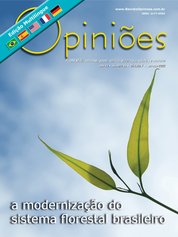Fabrício Gomes de Oliveira Sebok
Product Development Manager at Bayer
OpCP69
The temporal, causal and effective modernization of the Brazilian forest system
The modernization of the forest system is usually related to robots, embedded high technology, autonomous and flying vehicles, artificial intelligence, remote monitoring and decision-making, Big Data and many other examples that would be applied to forestry.
With this, the technological evolution of the entire chain over time is clear, thus supplying silvicultural demands, keeping Brazil as a leader in the productivity of planted forests and ensuring the chain's competitiveness. However, we would be restricting ourselves if we only consider high technology as something that references the modernization of the sector; adaptations of the agricultural sector have been driving forestry activities for a long time. The evolutionary process is dynamic and elastic, oscillating over time.
To paraphrase Plato and another philosopher, “necessity is the mother of invention and innovation always appears in moments of crisis”; the theme warns us that we must first identify bottlenecks and then solve them. Relatively simple adaptations, such as protected bars, or also known as conceição, can bring greater grip and modernization than robots that are still impractical in the field, precisely because they are directly solving a clear problem, which would be the lack of manpower. and the risk of phytotoxicity caused by non-selective herbicides.
However, it is not always easy or simple to identify these triggers. As an example, it was not always so clear how the ruderal plants that infest forest plantations would be harmful to the development of the planted forest, much less that this would depend on the positioning, intensity of infestation and time in which they would be competing. And yet, that different sites would respond in different ways due to environmental conditions and the species or clones implanted in the areas.
When it was understood that there was a need to control this vegetation more effectively to avoid weed competition, solutions were sought, such as the practice of fire, which made the area free from infestations, despite the other damage it caused, but was still being something modern for the moment. At the same time, other adapted forms of agriculture were also used, such as intensive soil preparation with plowing and harrowing, practices that, without a shadow of a doubt, were revolutionary for the sector.
Over time, agricultural herbicides were introduced, which allowed for greater agility and less dependence on manpower to control the weeds. Subsequently, products with forest recommendations were registered, and pre-emergent herbicides were introduced, which brought even more modernity to management, reducing interventions and management costs.
The use and supply of herbicides did not occur by chance, but are the result of the need for efficient solutions to the labor difficulties in combating weeds and the opportunity for chemical industries to bring their solutions to the forestry sector. Over the last few years, the amount of forest chemical or biological products has been increasing, which demonstrates that the sector has gained strength, visibility, and, why not, modernity.
According to the electronic portal of the Ministry of Agriculture, Livestock and Supply, Agrofit, there are around 314 chemical and biological products registered for the protection of forests in Brazil, of which 218 are herbicides. Considering that, until recently, the herbicide options registered were few, we are living in a moment of abundance. However, although this number appears to be diverse, the number of different herbicide molecules and mixtures registered is no more than 37, and only 10 active ingredients represent 90% of the products registered for the sector, namely: glyphosates (56%), glufosinate (8%), chlorimuron-ethyl (7%), flumioxazin (5%), sulfentrazone (3%), isoxaflutol (2%), carfentrazone-ethyl (2%), oxyfluorfen (2%), quizalofop-P-ethyl (2%) and triclopyr-butyl (2%), although the remaining 10% represent more recent molecules, formulations and mixtures, with high technology added.
In any case, herbicide products are composed of active ingredients, adjuvants and inerts, which guarantee stability and the necessary requirements for their efficiency in application, control and safety. And so, to extract the full benefit of these technologies, it is not enough to have the best choice of product, but that phytosociological surveys of weeds are also carried out, that adequate and regulated equipment is used, correct positioning and the appropriate moment of application. In other words, innovation and knowledge must walk together so that it is not just an apparent and fragile modernization.
It is important that every forestry professional feels part of this modernization of the Brazilian forest system and dedicates himself to understanding the problems faced and the search for innovative solutions. Despite being complex and dependent on joint actions, the sector pursues the same objective, which is efficiency in sustainable forestry production. Examples such as self- propelled sprayers, applications of defensive products via drones, genetically modified eucalyptus trees ensuring tolerance to herbicides, infestation mapping remotely, remote inventories, all of this is already part of modern forestry, which seeks greater precision and efficiency.
Definitely, modernization is something dynamic, which is always updated, according to the needs found. What is modern today will become obsolete in the near future, but this makes it even more relevant for the modernization of the Brazilian forest system, as all the learning generated during its operation will be used during the process of generating new technologies.




